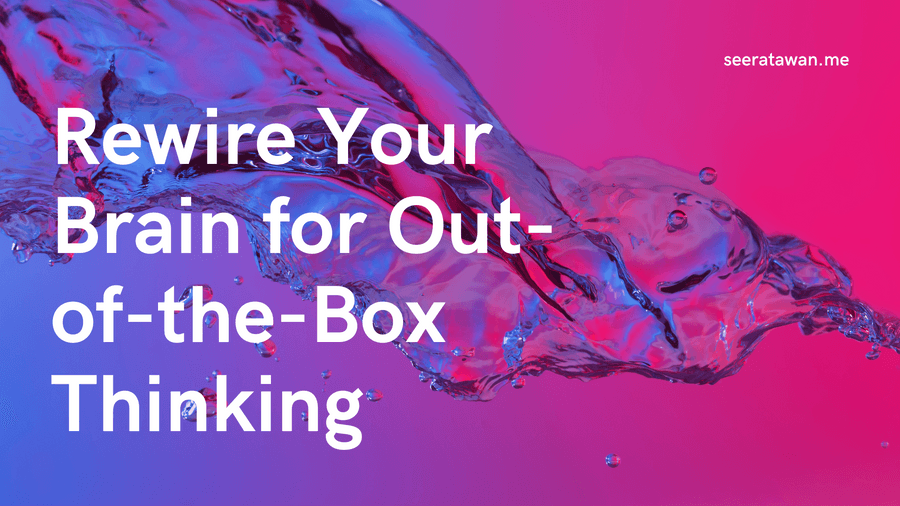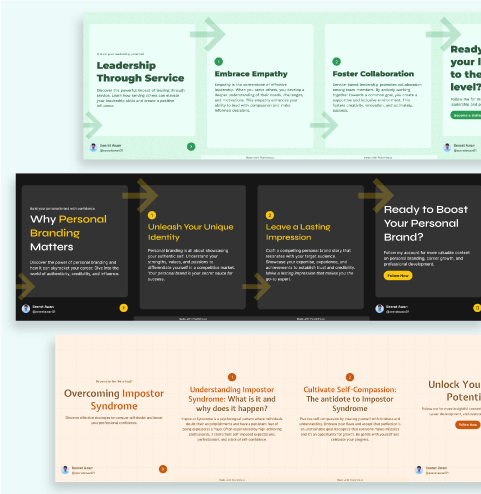· 9 min read
Unlock Innovation - How to Rewire Your Brain for Out-of-the-Box Thinking
Challenge assumptions, disrupt routines, and stimulate creativity using the B.R.A.I.N. framework.

We all want to have great ideas and think more creatively. But our minds crave predictability, defaults, and habitual thinking.
We can’t solve problems by using the same kind of thinking we used when we created them. — Albert Einstein
The good news is, we can purposefully jolt ourselves out of mental ruts using the B.R.A.I.N. Innovation Framework .
Let’s explore how each step can rewire your brain to think in inventive new ways.
The Need to Think Different
Imagine you’re an inventor in the late 1800s trying to develop a new form of transportation. Cars don’t yet exist. If you used conventional thinking, you may try to optimize carriages by designing faster horses or smoother roads. But this linear approach merely improves the existing paradigm.
To fundamentally transform transportation, you need lateral thinking. This spark of ingenuity only comes when you challenge assumptions and imagine without limits. You envision mechanical vehicles powered by combustion engines. Radical innovation requires thinking differently.
Our minds naturally extrapolate from the familiar. When problem solving, we reflexively retrieve existing solutions rather than seeing the problem afresh. Cognitive biases and assumptions box us in. But as Henry Ford said, “If you always do what you’ve always done, you’ll always get what you’ve always got.” To conjure the new, we must disrupt old thought patterns.
The B.R.A.I.N. Framework provides structured techniques to jolt you out of mental habits. By purposefully “thinking wrong,” you can rewire your brain’s connections to unlock creativity.
Let’s explore the key steps.
Break Patterns
Like a well-worn rut in a dirt road, our neuronal pathways get entrenched in predictable behaviors and thought sequences. We operate on mental autopilot. A study by researchers at University College London found that over 40% of our daily actions are performed habitually with little conscious thought.
To boost innovation, you need to disrupt these habitual grooves. Changing routines and exposure to new stimuli literally reshape your brain’s synaptic connections through neuroplasticity. It forms fresh neural pathways and associations.
Consider ways you can break your standard patterns:
- Walk or drive a different route to work
- Listen to a new music genre like jazz or classical
- Read different books, magazines or blogs outside your norm
- Rearrange furniture or work in a different room
- Take mini-breaks throughout the day to walk somewhere new
- Switch up morning rituals like having tea instead of coffee
- Impose randomness into activities by rolling a dice or using a random number generator
- Visit new neighborhoods, museums, stores, or restaurants
The precursor to any breakthrough is breaking out of the old box.
By disrupting repetitive behaviors and external cues, you challenge your brain’s status quo. Even small changes lead to new connections and perspectives. Shake up your routines to reshape your thinking.
Restrict Choices
Creativity often consists of merely turning up what is already there. Did you know imposing limits can actually boost innovation?
Rather counterintuitively, having too many options can hinder imagination. Research shows that excessive choice overwhelms our working memory, immobilizing us.
Constraints clearing restrict the possible solutions, which forces lateral thinking. With limited options, your brain can’t rely on familiar responses. Restrictions force you to visualize possibilities outside your normal box. Imposing creative constraints activates different neural networks and cognitive capacities.
Try these unique challenges to get your creative juices flowing:
- Compose a short story using a set of random, unrelated words
- Code a program in a new programming language.
- Make a recipe using seemingly incompatible ingredients
- Write a song with three chords or notes
- Sketch a painting using only black and white
By stripping away infinite options, restrictions direct your focus, allowing space for ingenious thinking. Limiting your choices stimulates novelty.
Analyze Assumptions
The premises we take for granted powerfully shape our thinking without us realizing it. Questioning assumed “truths” opens you to alternative perspectives. Identify the core assumptions that underlie your business, strategy and beliefs.
Scrubbing your windows on the world occasionally, or the light won’t come in.
Start by listing 20 beliefs, practices, or “facts” you assume regarding an issue. Then select 1-2 to challenge or reverse. Common business assumptions worth flipping include:
- Our customers are price-sensitive vs. value-driven
- Protecting our current product line is the best way to retain market share
- Experience level always equates to value
By challenging underlying assumptions, you clear space for disruptive thinking. Test the validity of your premises before cementing them as indisputable truths. Be willing to flip perspectives entirely.
Inspire Novelty
Exposure to unrelated or random stimuli activates your brain’s associative networks, allowing you to connect dots in unconventional ways.
Discovery consists of seeing what everybody has seen, and thinking what nobody else has thought.
Novel inputs prompt your brain to loosen existing connections and form new ones. Here are ways to inject novelty:
- Read books, magazines or blogs from other disciplines
- Browse eccentric publications like Modern Farmer or Make: DIY projects
- Listen to new genres like Afrobeat, jazz, or bluegrass
- Visit art galleries, hobby stores, international markets
- Study random patents to spark ideas
- Take idea “safaris” by exploring new neighborhoods
- Initiate conversations with those outside your field
The unusual stimuli poke your brain out of stale thought patterns. Absorb diverse influences so your mind can generate fresh, innovative connections.
Nap & Daydream
Finally, don’t underestimate the creative power of your subconscious. Conscious thought is just the tip of the iceberg when it comes to our brain’s activity. While deliberate focused work is key, don’t forget to also let your deeper mind churn away with a problem.
Disengaging conscious thought allows different parts of your brain to make new associations below the surface. Many famous “eureka” moments occurred while napping or relaxing - like the structure of the benzene molecule coming to Kekule in a dream.
Einstein and Salvador Dali also knew the benefits of daydreaming to access the subconscious. Stepping away from active thinking encourages your brain to recombine ideas in inventive ways.
Make time for contemplative relaxation, mind-wandering and decent sleep. Don’t just rely on forcing creative solutions. Let innovative insights percolate and emerge when you unfocus.
Understanding the Science
Neuroscience and cognitive research help explain why the B.R.A.I.N. techniques work:
Breaking patterns: Neuroplasticity shows that novel and varied experiences physically rewire neural connections. Disrupting habits creates new pathways.
Restricting choices: Constraints activate different cognitive control areas like the prefrontal cortex while reducing overload. This enhances focus and flexibility.
Analyzing assumptions: Questioning assumptions builds cognitive flexibility and cortical thickness in brain regions associated with creativity.
Inspiring novelty: Exposure to random stimuli triggers associative thinking and remote connections in the right hemisphere.
Napping & daydreaming: Rest and mind-wandering strengthens connections. REM sleep also integrates unassociated concepts in the visual cortex.
Science confirms that purposefully stressing your brain’s capacities boosts out-of-the-box thinking by forming new circuitry. Utilize the structured B.R.A.I.N. Framework to literally reshape your neuronal connections and cognitive processes. Thinking differently rewires your brain for innovation.
Real-World Examples
Let’s look at how innovators throughout history have intuitively used these techniques:
Break patterns: Richard Feynman, the Nobel Prize physicist, was famous for random adventures like visiting obscure libraries or learning random subjects to infuse new thinking.
Restrict choices: Architect Frank Gehry boosts creativity by physically building models with material constraints like cardboard. It forces ingenious design.
Flip assumptions: By questioning the assumption that computers must be huge mainframes, IBM researchers invented personal computers and created an industry.
Inspire novelty: The Wright brothers gained critical insight into aerodynamics from studying how birds flew, cross-pollinating ideas from nature.
Nap and daydream: Salvador Dali would sit in a chair holding a spoon over a tin plate. As he fell asleep, the spoon would clatter and wake him, allowing him to capture fleeting dreams and odd visions.
Throughout history, pioneers have intuitively and systematically disrupted their standard modes of thinking. While unpredictable, thinking differently opens the door to creativity.
Tips to Apply the B.R.A.I.N. Framework
Here are some practical tips for putting this framework into action:
Break patterns:
- Set reminders to change habits and routines at least 3 times this month. Try new commute routes, music genres, lunch spots.
- Keep a “disruption journal” to log any mental blocks. Describe how you shook things up.
Restrict choices:
- Brainstorm creative constraints to impose on a current project, like using only certain ingredients or shapes.
- Sketch 10 product concepts under very tight constraints like using one material. See what innovative results emerge.
Flip assumptions:
- List key beliefs about your business. Select 2 assumptions to challenge. How would the opposite change your strategy?
- Have team members anonymously submit assumptions about the company. Discuss which to flip or validate.
Inject novelty:
- Visit a museum, supplier, or neighborhood unrelated to your industry. Note any observations that could spark ideas.
- Subscribe to an offbeat publication outside your domain. Schedule time to read it.
Nap & daydream:
- Take regular breaks to walk outside or doodle. Don’t pressure yourself to always be productive.
- After intensive work, take 15-30 minute nap breaks to recharge your subconscious thinking.
Leverage the whole B.R.A.I.N. Framework in sequence to maximize your cognitive flexibility and creative capacity.
Overcome Resistance to Thinking Differently
Trying these techniques may initially feel counterproductive. Your brain wants efficiency and resists unpredictable stimulation. Pushing past this reluctance is key.
Consider ways to lower the perceived risks and make the benefits more visible:
- Start small with low-stakes experiments vs. radical changes.
- Do exercises individually first before introducing to the team.
- Share examples of how these techniques led to innovations.
- Celebrate failed attempts. It shows the right risk-taking mindset.
- Remind people creativity is a muscle developed over time.
With consistent practice, your brain will adapt and thinking differently will start to feel natural.
Creativity is a Journey, Not a Destination
Thinking innovatively on demand is impossible. But you can nurture the conditions that allow creative insights to emerge. Applying the B.R.A.I.N. framework flexes your mental capacity for original ideas, but don’t force them.
You can’t connect the dots looking forward; you can only connect them looking backwards. — Steve Jobs
The techniques prepare the dots. Give your brain space to link them in nonlinear ways. Stay curious, playful and open to whatever may materialize.
Keep questioning stale conventions and rewiring your perspectives. Thinking wrong on purpose opens portals to imagination. By tricking your brain out of its habitual grooves, you clear the path for your mind to wander into brilliance.
I hope you enjoyed this article!
- creative-thinking
- innovation
- neuroscience
- cognitive-psychology
- lateral-thinking
- creative-constraints
- assumptions
- novelty
- daydreaming
- creativity
- constraints

Subscribe to my newsletter to get the latest updates on my blog.

